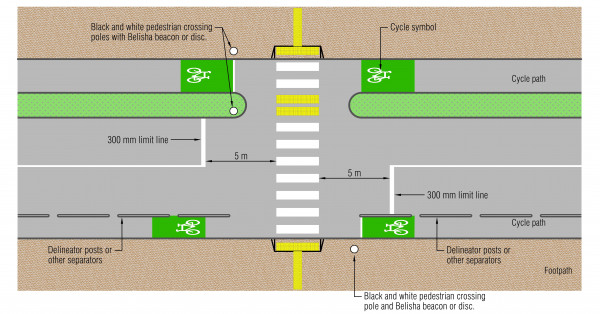TCD Rule Clause 8.2 stipulates the following requirements for pedestrian crossings (zebra):
(1) A road controlling authority may, except for areas controlled by traffic signals, mark a pedestrian crossing on a road for which a speed limit of 50 km/h or less is set.
(2) A road controlling authority may mark a pedestrian crossing on a road for which a speed limit of more than 50 km/h is set if it has obtained the approval of the Agency and complies with any conditions specified in the approval. […]
(5) A pedestrian crossing must not, by 30 June 2006, exceed 15 m (see note 1) from one side of the roadway to the other side unless it is:
(a) interrupted by one or more traffic islands to form two or more pedestrian crossings; or
(b) replaced by traffic signals.
(6) Markings for a pedestrian crossing must be placed, as far as practicable, either at right angles to the middle line of the roadway or so as to provide the most convenient route for pedestrians.
(7) A pedestrian crossing must be placed so that:
(a) it is visible to driver approaching the crossing from any direction; and
(b) the driver’s view of the entire length of the pedestrian crossing is unobstructed by any permanent growth, construction or physical feature.
(8) A pedestrian crossing, other than a pedestrian crossing that in the opinion of the road controlling authority will not generally be used at night, must be kept illuminated when street lights are operating so that the crossing markings and a pedestrian on the crossing are visible.
(9) A road controlling authority must install, within 2 m from each end of a pedestrian crossing and on a traffic island that separates two pedestrian crossings, a pole that is:
(a) 75 mm or more in width and 2 m or more in height; and
(b) marked with alternate parallel bands of black and white, which may be reflectorised, each of which is approximately 300 mm wide.
(10)A road controlling authority must place on every pole in 8.2(9) either:
(a) an internally illuminated amber globe (that may flash at between 40 to 60 flashes each minute) that is 300 mm or more in diameter; or
(b) a fluorescent, reflectorised orange sign in the form of a disk that is 400 mm or more in diameter.
(11) To inform approaching traffic of the presence of a pedestrian crossing, a road controlling authority, on each approach to the pedestrian crossing:
(a) must place a pedestrian crossing warning sign before the pedestrian crossing; and
(b) must, if practicable, mark a limit line that consists of a white line that is not less than 300 mm wide and not less 5 m from the pedestrian crossing; and
(c) may mark a pedestrian crossing warning marking in the form of a diamond on the road surface.
A white diamond road marking installed at least 50m and no more than 100m in advance of the crossing is not mandatory but remains good practice and should be installed.
Note 1:
Although pedestrian crossings (zebra) may be legally up to 15m long, none should be longer than 10m.
Refer to the Pedestrian Network Guidance
Note 2:
5.4(1A) Despite 5.4(1) and 5.4(2), the Agency may, by notice in the Gazette, authorise the installation and maintenance of a marking that does not comply with the colour, shape, dimensions, letters, words, numerals, or symbols specified in Schedule 2.
On the 13 January 2021 Waka Kotahi NZ Transport Agency published Land Transport Rule gazette notice No 2021-au89 approving new and interim pedestrian crossing markings.
Land Transport Rule gazette notice(external link)
Special care is required when locating pedestrian crossings (zebra) so that they are at a desirable location for both pedestrians and drivers. This is especially so at intersections.
For further details on pedestrian crossings (zebra) and the process for determining whether a pedestrian crossing (zebra) is the best option refer to:
Pedestrian crossings (zebra) should be marked as indicated in Figure 7‑10, Figure 7‑11, and Figure 7‑12 below.
The centre-line should always stop short of the crossing point, at the limit line. If a pedestrian crossing (zebra) is installed on a road with no centre-line, a centre-line should be marked from the limit line to the upstream end of the advance warning diamond.
A centre-line marked through a pedestrian crossing (zebra) does not legally divide it into two separate crossings.
All pedestrian crossings (zebra) must have a limit line marked as follows, unless such a marking is impracticable.
Table 7‑3: Pedestrian crossings (zebra) limit lines
| Colour | Reflectorised white |
|---|---|
| Width | 300mm minimum |
| Stripe | Continuous |
| Location | 5m from the crossing point |
On each approach to a pedestrian crossing (zebra) no-stopping lines should be marked not more than 1m out from the kerb or edge of seal and for a minimum distance of 6m prior to the crossing. On rural roads (where a pedestrian crossing (zebra) must be approved by Waka Kotahi NZ Transport Agency) or where operating speeds are greater than 30km/h, the distance should be increased to 15m.
Where school patrols operate, no-stopping line markings should be provided for a minimum of 15m on both approach and departure sides of pedestrian crossings (zebra).
Where kerb extensions are provided, no-stopping lines may be omitted.
Advance warning diamond symbols, if marked, should be located not less than 50m in advance of the pedestrian crossing (zebra) and in the centre of each approach lane. Advance warning diamond symbols should be marked as follows.
Table 7‑4: Pedestrian crossings (zebra) advance warning diamond
| Colour | Reflectorised white |
|---|---|
| Line width | 100mm minimum |
| Diamond | 0.6m x 4m (minimum), 1m x 6m (desirable) |
| Proportions |
As indicated in |
Advance warning diamond symbols should be located so they are clearly visible to approaching drivers for at least 50m.
The bars of pedestrian crossings (zebra) should be marked parallel to the direction of approaching traffic and must be placed as far as reasonably practicable:
Any new pedestrian crossing installed or remarked following resealing should be in the M1-1.3, 600 x 600 (new format) as shown in Figures 7-10, Figure 7-11 and figure 7-12.
All existing M1-1, 300 x 600 pedestrian crossings, when being remarked for maintenance, should be remarked in the M1-1.2, 450 x 450 (interim format) through the addition to the marking stripe width by 150mm and thereby reducing the gap by the corresponding amount as per the Land Transport Rule gazette notice.
Land Transport Rule gazette notice(external link)
Table 7‑5: Pedestrian crossings (zebra) markings
| Format |
New format |
Interim format |
|---|---|---|
| Colour |
Reflectorised white - note that the roadway must contrast with the white crossing markings.
|
|
| Bar width | 600mm | 450mm |
| Gap | 600mm | 450mm |
| Bar length | 2.0m (minimum) | |
The length of bars may be increased to provide greater visual impact or to provide wider crossings where there are large pedestrian volumes.
The Rule does not specify the required roadway colour to provide a contrast to the white lines. If the roadway is to be resurfaced or marked to improve the contrast between the roadway and the white lines, care is required to ensure that the contrast is visible to all road users; in this regard, visually impaired road users have reported that red and pink colouring between the white lines does not provide adequate contrast.
Signs for midblock pedestrian crossings (zebra) are provided in Table 7‑6.
The W16-4.1 children flag/kea crossing flags must not be used for school patrols operating at pedestrian (zebra) crossings. A kea crossing is a part time crossing facility and therefore depends on the temporary W16-4.1 flags for their conspicuity. Using W16-4.1 flags at zebra crossings undermines the effectiveness of the flags at kea crossings as well as the permanent nature of the pedestrian crossing facility to the road user.
For information on sign specifications such as sign size, reflectivity and legend details refer to the sign specifications.
Table 7‑6: Signage for pedestrian crossings (zebra)
| Sign code | Example | Description/use |
|---|---|---|
|
W16-2 Pedestrian crossing |
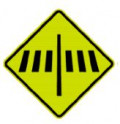 |
Must be installed in advance of all marked pedestrian crossings. (See 8.2(11) TCD Rule) Crossings should be:
Must not be used:
For sign location (see note 1) |
|
W16-3 Belisha beacon disc |
|
Poles which indicate the positions of pedestrian crossings (zebra) must be at least 75mm diameter, at least 2m high and be marked with alternate parallel bands of black and retroreflective white sheeting of minimum Class 400 performance. A pole must be located within 2m of each end of every pedestrian crossing (zebra), preferably on the approach sides to crossings, and at the end of pedestrian refuge islands (including on central islands). Pedestrian crossings (zebra) divided by a raised central median or pedestrian refuge island must have poles to mark the ends of each separate crossing, i.e. at the road sides and at the central raised central median or pedestrian refuge. A Belisha beacon disc or a Belisha beacon must be installed on every black and white pole specified above and in Where beacons are provided they should consist of 300mm minimum diameter yellow/amber spheres with a minimum light output of 650 lumens. Beacons should have a flashing rate of between 40 to 60 flashes per minute and should be located so that they are visible to all approaching traffic. It is better to use Belisha beacons where there are a lot of urban signs and light clutter. |
Table 7-6 notes:
On-roadway flashing light pedestrian crossing (zebra) warning involves the installation of internally illuminated pavement markers placed laterally across the roadway and a series of three markers longitudinally before the pedestrian crossing (zebra). The markers flash in the direction of approaching drivers when a pedestrian is detected waiting to cross. Pedestrians are expected to use the crossing in the same way as they do for a normal pedestrian crossing (zebra) (the lit markers are not generally visible to them) and motorists apply the normal give way rule.
The TCD Rule Clause 8.2 allows the following for the installation of illuminated markings and markers at pedestrian crossing (zebra) areas:
(12) To inform approaching traffic of the presence of a pedestrian waiting to cross at a pedestrian crossing, a road controlling authority may install and maintain an on-roadway flashing yellow light system that is:
(a) installed as described in diagram M1-4 of Schedule 2 [of the TCD Rule]; and
(b) illuminated only when a pedestrian waiting to cross is detected and remains illuminated only for a period sufficient to permit the pedestrian to cross the pedestrian crossing.
The TCD Rule does not specify the form of detection but does require the system to be “illuminated only when a pedestrian waiting to cross is detected and remains illuminated only for a period sufficient to permit the pedestrian to cross the pedestrian crossing” (TCD Rule clause 8.2(12)(b)).
Further details of the location and layout of the illuminated road markers is provided and summarised below.
Warning lights should be located at sites where the crash history and local knowledge warrants that some additional advance warning is necessary. These could be locations where:
The TCD Rule requires the lights to be installed as shown in Figure 7‑7, Figure 7‑8, and Figure 7‑9.
The diagrams show:
The lateral lights should be installed so they are not aligned, as much as is possible, with vehicle wheel tracks. The trials showed five lights are effective for crossing widths of between 6m and 10m, however, more lights may be considered necessary where crossing widths exceed 10m.
Figure 7‑7: Placement of warning lights - two-lane, undivided roadway
 View larger image [JPG, 2.4 MB]
View larger image [JPG, 2.4 MB]
Figure 7‑8: Placement of warning lights - two-lane, undivided roadway with pedestrian refuge island
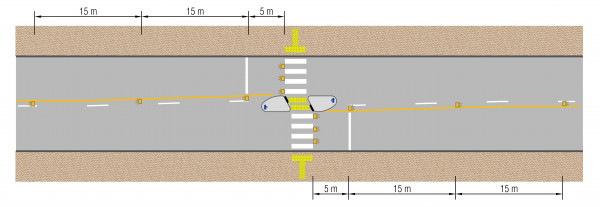
View larger image [JPG, 2.5 MB]
Figure 7‑9: Placement of warning lights - divided roadway
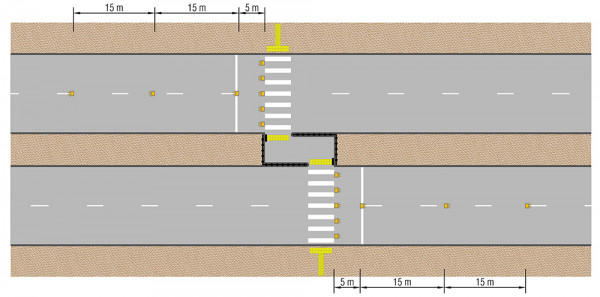
View larger image [JPG, 345 KB]
Pedestrian crossings (zebra) must be illuminated during the hours of darkness and when the street lights are operating in the vicinity, unless the RCA considers that a particular crossing will generally not be used at night (TCD rule clause 8.2(8)).
Lighting for pedestrian crossings (zebra) should meet the requirements of AS/NZS 1158.4: 2009 Lighting of Pedestrian Crossings.
A pedestrian crossing (zebra) may be combined with other facilities, such as kerb buildouts, pedestrian refuge islands, and / or speed platforms. Layouts for some combinations are shown in Figure 7‑10, Figure 7‑11, and Figure 7‑12.
Figure 7‑10: Typical layout for pedestrian crossing (zebra) with kerb extensions
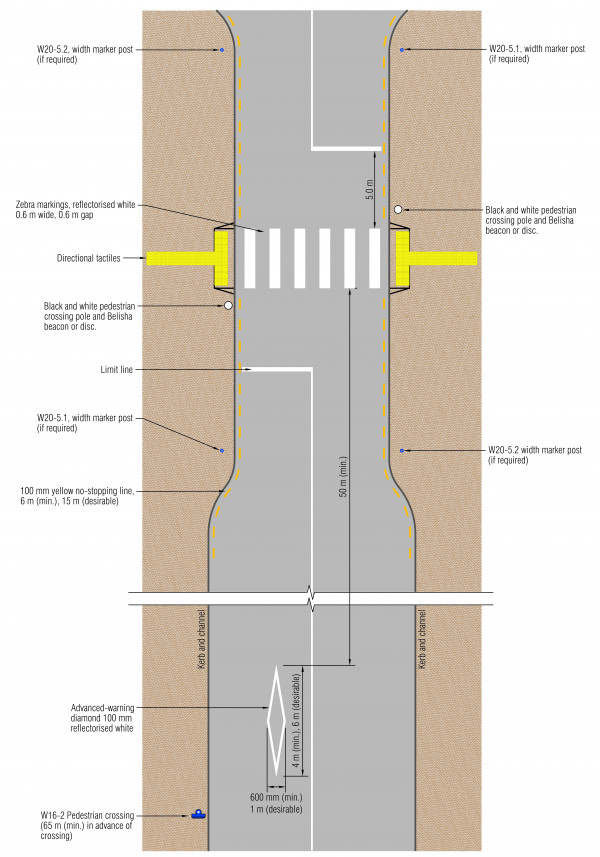
View larger image [JPG, 10 MB]
Figure 7‑11: Typical layout for pedestrian crossing (zebra) on raised platform
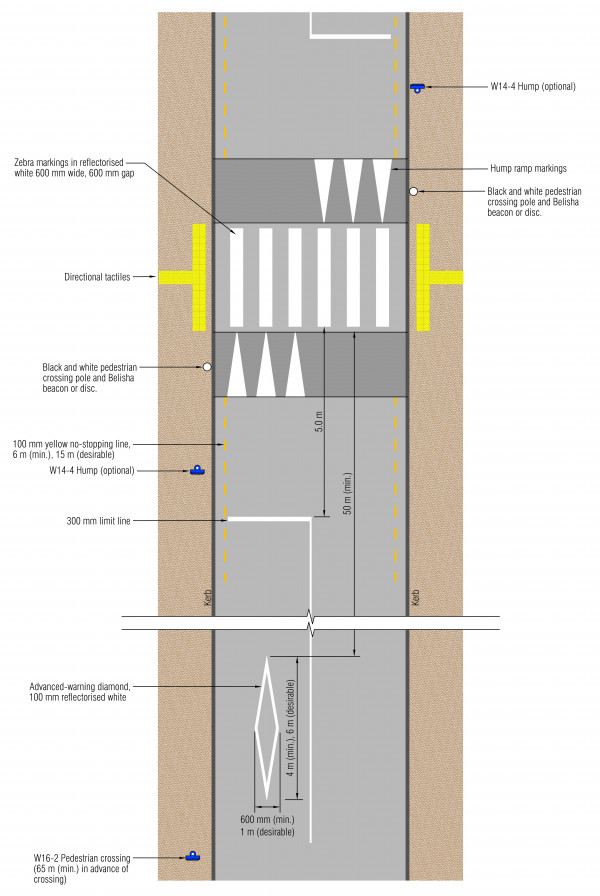
View larger image [JPG, 7.6 MB]
Where a pedestrian crossing (zebra) is marked on a two-lane road marked with a flush median, a pedestrian refuge island should be constructed, to divide the crossing into two separate crossings.
If it is impracticable to provide a pedestrian refuge island, the crossing bars should be marked through the interrupted flush median markings Such pedestrian crossings (zebra) should be kept to an absolute minimum, where they are used, consideration should be given to measures to better highlight the presence of the pedestrian crossing (zebra) for drivers.
Figure 7‑12: Typical layout for pedestrian crossing (zebra) with pedestrian refuge island in a flush median
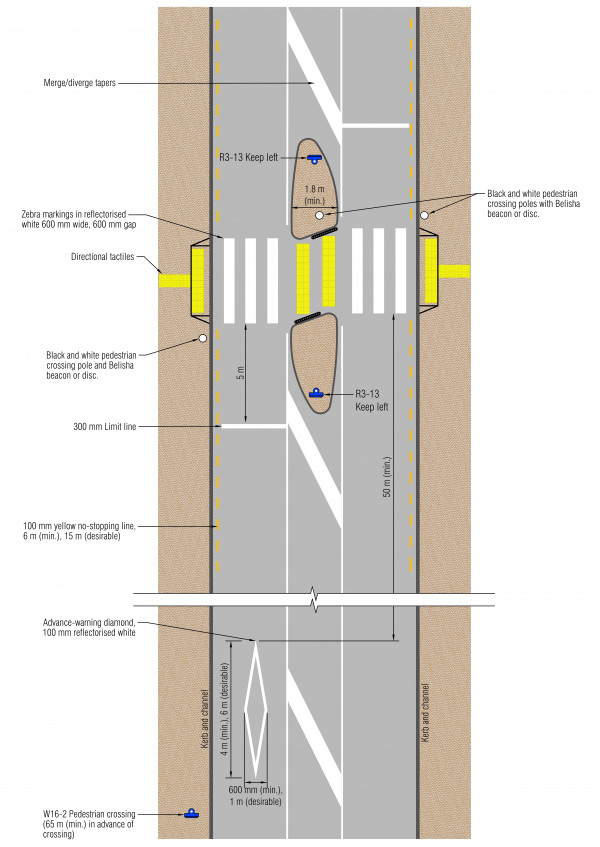
View larger image [JPG, 8.2 MB]
Figure 7‑12 note:
It is recommended that pedestrian crossings (zebra) are not installed on multi-lane roads due to the safety risks associate with such facilities.
If pedestrian crossings (zebra) are located on multi-lane roads they should be marked as two separate crossings, not exceeding 10m in length and should be divided by a centrally located pedestrian refuge island. The minimum recommended width for a pedestrian refuge island is 1.8m.
On multi-lane roads it is preferable, where possible, to install kerb extensions to minimise the width of pedestrian crossings (zebra) and to position pedestrians waiting to cross outside of vehicles parked on the approaches to crossings.
Where a pedestrian crossing (zebra) is installed across a road with cycle lanes or cycle paths, the cycle lane or cycle path may be continued through the crossing. However, the kerb buildouts required to achieve a maximum crossing distance of 10m may represent a ‘pinch point for cyclists. Designers should take care to appropriately manage the conflict that may arise from this situation. Such as by installing pedestrian refuges between opposing traffic lanes or between cycle lanes or paths and the traffic lane.
Refer to Figure 7‑13 for recommended cycle lane layouts at a typical pedestrian crossing (zebra) with kerb extensions. It is important that the cycle lane is not terminated prior to the kerb extension and that a taper of not less than 1 in 30 is achieved for the cycle lane where it tapers from a kerbside alignment. Where kerb extensions are provided to ensure sufficient intervisibility, but result in insufficient cycle lane width, more upstream parking could be removed, or the general traffic lane narrowed. An advanced stop line (ASL) as per a normal intersection configuration should also be used.
Figure 7‑13: Typical layout of a pedestrian crossing (zebra) with on-road cycle lanes
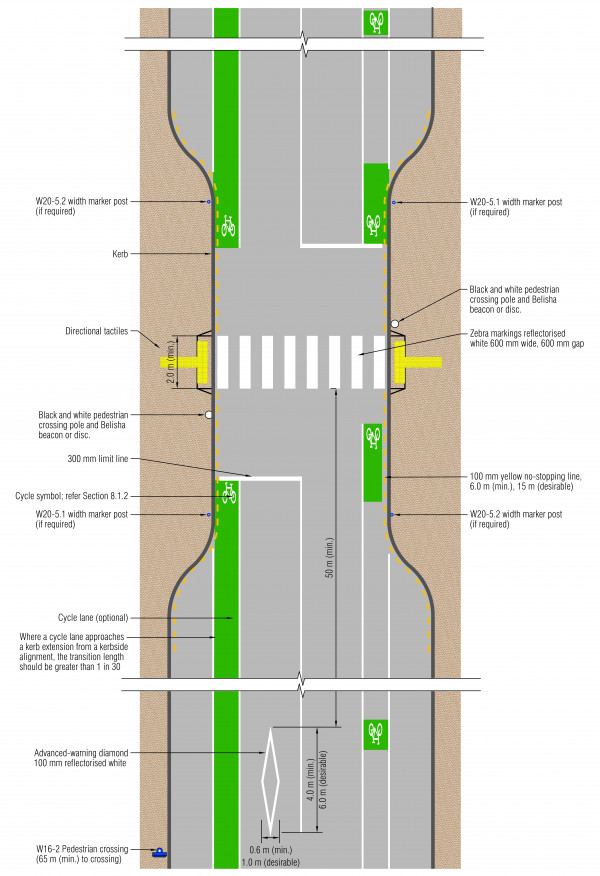
View larger image [JPG, 8.1 MB]
Where a pedestrian crossing (zebra) is installed on a road with cycle path(s), special consideration should be given to the treatment of cycle path(s) to avoid creating additional risks for pedestrians or cyclists.
The following treatments may be used:
Figure 7‑14: Typical layout for a pedestrian crossing (zebra) with a cycle path (cycle path is interrupted)
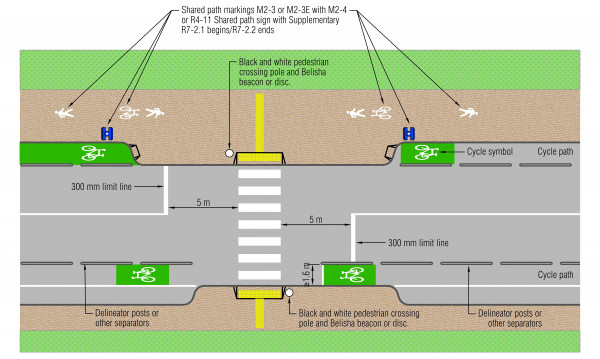
View larger image [JPG, 4.8 MB]
Figure 7‑15: Typical layout for a pedestrian crossing (zebra) with a continuous cycle path
